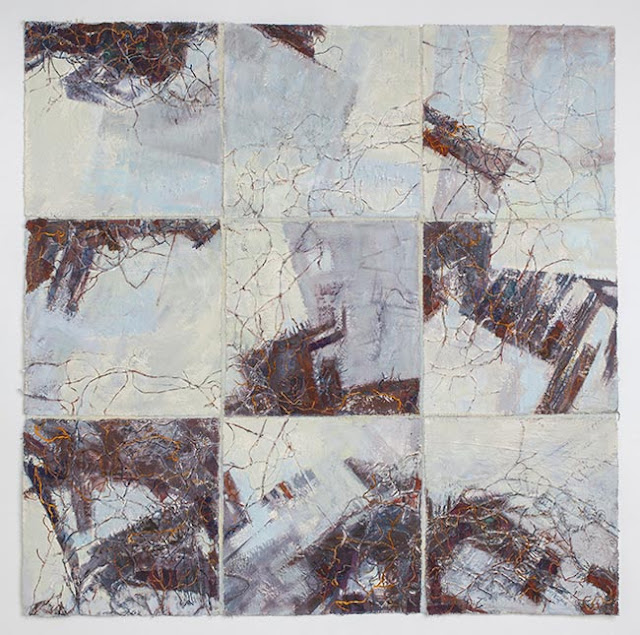It is fit for purpose as the piece is an embroidered wall hanging, and I feel that it successfully demonstrates my concerns for Global Warming and its effect on Inland Wetlands.
I am extremely happy with the resulting conclusion. The work is very similar to my original design, but has been adapted and evolved slightly as I have noticed exciting design opportunities along the way. I like the way it demonstrates global warming with very subtle colour change effects when heat is applied. I like the way I've left gaps in the reeds and produced a lace like effect in the water, so that light shines through the gaps, hoes and spaces, and I'm happy that I manged to achieve the effect that the work is suspended 'in mid air' by use of the fishing wire.
Hopefully, as the work is suspended within a frame, the hanging could be placed in a window, attracting sunlight. The warmth of the sun would allow the thermochromic colour change effect that is designed to imply Global Warming.
If I were asked to make the hanging again, I think I would pay greater attention to the back of the work, so that it could be hung/displayed in a more central location and be viewed from all directions.
Costing:
Papers for design work £5.00
Paints for design work £5.50
Polyester fabric £3.50
Transfer dyes £4.50
Romeo Aquafilm £15.00
Thread £35.00
Wood £15.00
Screws and brackets £7.50
Total: £91.00
Timing
Design work: 3 hours
Total work spent on embroidery and construction: 115 hours
Authentication:
Storage of Tools and Equipment:
Design work in progress: kept flat, in a large folder.
Completed embroidery: wrapped in acid free tissue paper inside a box.
Completed design work: kept flat, in a large folder.
Papers for design work: kept flat, in a large portfolio.
Inks and paints for design work: kept upright, with lids secure, inside store cupboard.
Glue, bleach & sprays: as above.
Embroidery work in progress: inside a workbox with needles, scissors etc, kept in a store cupboard
away from children and animals.
Fabrics: folded neatly, wrapped in acid free tissue paper and kept flat inside storage basket.
Threads: in special clear storage boxes for easy viewing, separated into colour groups.
Beads, metal threads etc: in acid free tissue paper inside storage box in store cupboard.
Dyes, paints, etc: kept upright, with lids secure, inside store cupboard.
Sewing Machine: kept upright on table in workroom, covered when not in use.
Other electrical equipment: on shelves in store cupboard, flex lightly wound.
Completed embroidery: wrapped in acid free tissue paper inside a box.
Completed design work: kept flat, in a large folder.
Papers for design work: kept flat, in a large portfolio.
Inks and paints for design work: kept upright, with lids secure, inside store cupboard.
Glue, bleach & sprays: as above.
Embroidery work in progress: inside a workbox with needles, scissors etc, kept in a store cupboard
away from children and animals.
Fabrics: folded neatly, wrapped in acid free tissue paper and kept flat inside storage basket.
Threads: in special clear storage boxes for easy viewing, separated into colour groups.
Beads, metal threads etc: in acid free tissue paper inside storage box in store cupboard.
Dyes, paints, etc: kept upright, with lids secure, inside store cupboard.
Sewing Machine: kept upright on table in workroom, covered when not in use.
Other electrical equipment: on shelves in store cupboard, flex lightly wound.
Health and Safety Rules Observed:
Dyes: care must be taken to avoid inhalation of particles when mixing dye powder. A mask should be worn at all times. Ensure dyes are stored out of the reach of children and pets.
Sewing Machine: ensure that lead is kept out of the way to avoid tripping over. make sure chair has a back rest and is at a comfortable height, especially during long periods of sewing.
Scissors: Ensure scissors are stored away safely and kept out of the reach of children
Pins and needles: Ensure pins and needles are kept in their correct cases and cushions. Make sure none fall on the floor and get trodden on.
Iron: Always disconnect iron when not in use, and ensure the lead is kept out of the way to prevent tripping. Store in a safe place when not in use.















